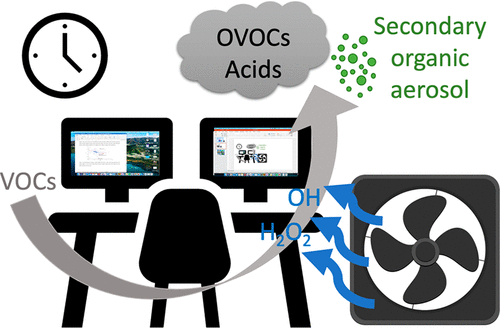当前位置:
X-MOL 学术
›
Environ. Sci. Technol. Lett.
›
论文详情
Our official English website, www.x-mol.net, welcomes your feedback! (Note: you will need to create a separate account there.)
Formation of Oxidized Gases and Secondary Organic Aerosol from a Commercial Oxidant-Generating Electronic Air Cleaner
Environmental Science & Technology Letters ( IF 10.9 ) Pub Date : 2021-07-14 , DOI: 10.1021/acs.estlett.1c00416 Taekyu Joo 1 , Jean C Rivera-Rios 2 , Daniel Alvarado-Velez 2 , Sabrina Westgate 2 , Nga Lee Ng 1, 2, 3
Environmental Science & Technology Letters ( IF 10.9 ) Pub Date : 2021-07-14 , DOI: 10.1021/acs.estlett.1c00416 Taekyu Joo 1 , Jean C Rivera-Rios 2 , Daniel Alvarado-Velez 2 , Sabrina Westgate 2 , Nga Lee Ng 1, 2, 3
Affiliation

|
The COVID-19 pandemic increased the demand for indoor air cleaners. While some commercial electronic air cleaners can be effective in reducing primary pollutants and inactivating bioaerosol, studies on the formation of secondary products from oxidation chemistry during their use are limited. Here, we measured oxygenated volatile organic compounds (OVOCs) and the chemical composition of particles generated from a hydroxyl radical generator in an office. During operation, enhancements in OVOCs, especially low-molecular-weight organic acids, were detected. Rapid increases in particle number and mass concentrations were observed, corresponding to the formation of highly oxidized secondary organic aerosol (SOA) (O:C ∼ 1.3), with an enhanced signal at m/z 44 (CO2+) in the organic mass spectra. These results suggest that organic acids generated during VOC oxidation contributed to particle nucleation and SOA formation. Nitrate, sulfate, and chloride also increased during the oxidation without a corresponding increase in ammonium, suggesting organic nitrate, organic sulfate, and organic chloride formation. As secondary species are reported to have detrimental health effects, further studies should not be limited to the inactivation of bioaerosol or reduction of particular VOCs, but should also evaluate potential OVOCs and SOA formation from electronic air cleaners in different indoor environments.
中文翻译:

商用氧化剂电子空气净化器形成氧化气体和二次有机气溶胶
COVID-19 大流行增加了对室内空气净化器的需求。虽然一些商用电子空气净化器可以有效减少主要污染物和灭活生物气溶胶,但对其使用过程中氧化化学形成次级产物的研究有限。在这里,我们测量了办公室内羟基自由基发生器产生的含氧挥发性有机化合物 (OVOC) 和颗粒的化学成分。在运行过程中,检测到 OVOC,尤其是低分子量有机酸的增加。观察到颗粒数量和质量浓度快速增加,对应于高度氧化的二次有机气溶胶 (SOA) (O:C ∼ 1.3) 的形成,有机质量中m / z 44 (CO 2 + ) 处的信号增强光谱。这些结果表明,VOC 氧化过程中产生的有机酸有助于颗粒成核和 SOA 形成。硝酸盐、硫酸盐和氯化物在氧化过程中也增加,但铵的含量没有相应增加,这表明有机硝酸盐、有机硫酸盐和有机氯化物的形成。据报道,次生物种对健康有害,进一步的研究不应仅限于生物气溶胶的灭活或特定挥发性有机化合物的减少,还应评估电子空气净化器在不同室内环境中潜在的 OVOC 和 SOA 形成。
更新日期:2021-08-10
中文翻译:

商用氧化剂电子空气净化器形成氧化气体和二次有机气溶胶
COVID-19 大流行增加了对室内空气净化器的需求。虽然一些商用电子空气净化器可以有效减少主要污染物和灭活生物气溶胶,但对其使用过程中氧化化学形成次级产物的研究有限。在这里,我们测量了办公室内羟基自由基发生器产生的含氧挥发性有机化合物 (OVOC) 和颗粒的化学成分。在运行过程中,检测到 OVOC,尤其是低分子量有机酸的增加。观察到颗粒数量和质量浓度快速增加,对应于高度氧化的二次有机气溶胶 (SOA) (O:C ∼ 1.3) 的形成,有机质量中m / z 44 (CO 2 + ) 处的信号增强光谱。这些结果表明,VOC 氧化过程中产生的有机酸有助于颗粒成核和 SOA 形成。硝酸盐、硫酸盐和氯化物在氧化过程中也增加,但铵的含量没有相应增加,这表明有机硝酸盐、有机硫酸盐和有机氯化物的形成。据报道,次生物种对健康有害,进一步的研究不应仅限于生物气溶胶的灭活或特定挥发性有机化合物的减少,还应评估电子空气净化器在不同室内环境中潜在的 OVOC 和 SOA 形成。



























 京公网安备 11010802027423号
京公网安备 11010802027423号